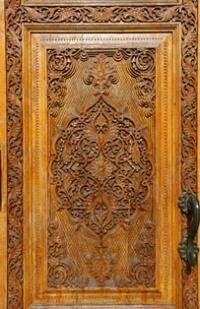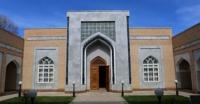You are here
Memorial complex Imam Al-Bukhari.



Visiting of architectural monuments of the Samarkand area.
“...it seemed a part of her life, to step from the ancient to the modern, back and forth. She felt rather sorry for those who knew only one and not the other. It was better, she thought, to be able to select from the whole menu of human achievements than to be bound within one narrow range”
Orson Scott Card.
Excursion to memorial complex Imam Al-Bukhari.
Muhammad ibn Isma’il Abu Abdallah al-Djufi al-Bukhari - outstanding Sunni theologian, titled "imam, a leader of Muhaddithes" and "amir, sultan of science about hadiths". Imam al-Bukhari was born in Bukhara in 810.
He devoted himself to studying of hadiths - legends about the Prophet. Being under 15, al-Bukhari had already known by heart the most authoritative works of that time. Having taken hadj in youth, al-Bukhari stayed in Hidjaz.
There, the scientist made biographical summa of hadith transmitters - "At-Ta’rih al-kabir". Collecting information about hadiths, imam al-Bukhari visited Egypt, Iraq and Khurasan. At the close of his days, al-Bukhari returned home, where in 870 year he died in Hartang village near Samarkand.
Having phenomenal memory, imam al-Bukhari had analyzed about 600 thousand hadiths, including 200 thousand he collected personally. Eventually, he created summa of true hadiths "Al-Djami as-Sahih", having been canonized by the 10th century as a fundamental collection of Sunni hadiths.
Imam al-Bukhari is known as the author of Koran interpretation - "Tafsir al-Kur’an". "As-Sahih" by al-Bukhari contains 7397 hadiths, thematically systematized in 97 books with 3450 chapters.
Such approach allowed imam to extend essentially a circle of legends, to classify hadiths in legal, historical, biographic, ethical and hygienic circles. That eased understanding of Sunna instructions and their practical use in solution of life problems for many generations of Muslims.
Spiritual exploit of imam al-Bukhari was witnessed by great figures of the Islamic East. Imam at-Termezi: "I have never met such scientist as Ismail al-Bukhari, which could so deeply feel and understand various defects available in hadiths and could restore their initial source”.
Abdurrahman Djami: "Tenga, minted in Balkh and Medina, has found its perfection and shine in Bukhara ". In the XVI century, the small mausoleum was built above the tomb of imam al-Bukhari.
Beside was constructed a mosque. In the connection with 1225th- anniversary of Imam al-Bukhari, according to the decision of the government of Uzbekistan, the new memorial complex was built in 1998 on the place of the old mausoleum.
The modern memorial complex consists of the mausoleum, mosque, office building and other structures around the yard. Height of the mausoleum dome - 17 m. The walls are decorated with light green, blue, white and glazed tiles, marble, onyx and granite. In the center of the mausoleum there is a tombstone coated with light blue onyx.
Under sagana there is a tomb of Imam al-Bukhari, covered with marble. Four-century old plane trees have preserved in the yard. Behind the mausoleum there is an educational center for hadiths studying.
At the left side of the yard there is a mosque for praying of 1500 believers simultaneously.
Authority:
Alexey Arapov. Samarkand. Masterpieces of Central Asia. Tashkent, San’at. 2004
Photos by
Alexander Petrov.







